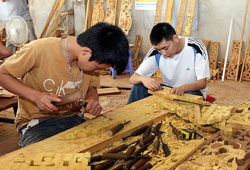- Home
- News
- Features
- Topics
- Labor
- Management
- Opinions/Blogs
- Tools & Resources
Unemployment, Training and Finding Work in Vietnam: A Big Job
Farmland in Vietnam is being gobbled up for development at the rate of 17,000 hectares — more than 65 square miles — per year, putting an annual average 238,000 poorly educated rural farmers out of work in the process.
Vietnam’s Communist government reports a “high” rate of rural unemployment of 3.74% during the first 9 months of 2011, according o the Vietnam News Service. Whether this percentage of rural unemployment correct is somewhat beside the point when viewed from the standpoint that development is taking up farmland, throwing loyal workers off their land.
The government’s answer has been job training and lots of it. This story from Viet Nam News claims one million people have received job training in the past 18 months. The only problem is , many of the newly “trained” workers can’t find jobs.
From Viet Nam News, an English-language daily
Finding a job
Ho Chi Minh City — Unemployment in rural areas, mainly caused by the reduction of farmland, has not declined, despite the Government’s effort to offer more vocational training programmes.
The Ministry of Labour, Invalids and Social Affairs reported that high unemployment in urban areas and lack of work in rural regions had become characteristic of the Vietnamese labour market.
According to the ministry’s statistics, the percentage of people of working age who lack jobs was 3.15% for the first nine months of the year, including 1.72% for urban areas and 3.74% in the rural region.
The 2010 figures were 2.04% for urban areas and 5.47% or rural areas, according to the General Statistics Office (GSO).
The rural unemployment rate increased by 0.02 per cent to 2.27% in 2010 compared to 2009. The rate for the first nine months of this year was 1.63%.
More than 17,000ha of farmland have been converted to serve industrial and urban development each year in recent years, according to statistics from MoLISA’s Institute of Settlement Research (ISR).
In a number of provinces, more farmland will be converted according to official planning until 2020.
An ISR research said each converted hectare of farmland made 14 farmers redundant.
Another institute survey showed that the number of farmers who had become hired workers had increased to 17% from 10% after their land was converted in some suburban areas in the Song Hong (Red River) Delta. But the report said the number was much higher in reality.
One of the major hurdles for rural workers is their poor education and low professional skills. As a result, a large number of rural migrants who have resettled in urban areas are unable to get high-quality jobs.
List your business in the premium web directory for free This website is listed under Human Resources Directory





